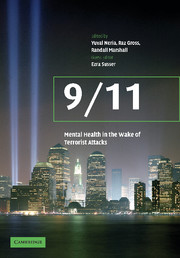Book contents
- Frontmatter
- Contents
- Acknowledgments
- Editors brief bio
- List of contributors
- Foreword
- Part I Introduction
- Part II The psychological aftermath of 9/11
- Part III Reducing the burden: community response and community recovery
- Part IV Outreach and intervention in the wake of terrorist attacks
- Part IV A New York area
- 16 PTSD in urban primary care patients following 9/11
- 17 Project Liberty: responding to mental health needs after the World Trade Center terrorist attacks
- 18 Mental health services support in response to September 11: the central role of the Mental Health Association of New York City
- 19 The New York Consortium for Effective Trauma Treatment
- 20 Evaluation and treatment of firefighters and utility workers following the World Trade Center attacks
- 21 The World Trade Center Worker/Volunteer Mental Health Screening Program
- 22 Child and adolescent trauma treatments and services after September 11: implementing evidence-based practices into complex child services systems
- 23 Relationally and developmentally focused interventions with young children and their caregivers in the wake of terrorism and other violent experiences
- Part IV B Washington, DC
- Part IV C Prolonged-exposure treatment as a core resource for clinicians in the community: dissemination of trauma knowledge post-disaster
- Part V Disasters and mental health: perspectives on response and preparedness
- Index
22 - Child and adolescent trauma treatments and services after September 11: implementing evidence-based practices into complex child services systems
from Part IV A - New York area
Published online by Cambridge University Press: 27 October 2009
- Frontmatter
- Contents
- Acknowledgments
- Editors brief bio
- List of contributors
- Foreword
- Part I Introduction
- Part II The psychological aftermath of 9/11
- Part III Reducing the burden: community response and community recovery
- Part IV Outreach and intervention in the wake of terrorist attacks
- Part IV A New York area
- 16 PTSD in urban primary care patients following 9/11
- 17 Project Liberty: responding to mental health needs after the World Trade Center terrorist attacks
- 18 Mental health services support in response to September 11: the central role of the Mental Health Association of New York City
- 19 The New York Consortium for Effective Trauma Treatment
- 20 Evaluation and treatment of firefighters and utility workers following the World Trade Center attacks
- 21 The World Trade Center Worker/Volunteer Mental Health Screening Program
- 22 Child and adolescent trauma treatments and services after September 11: implementing evidence-based practices into complex child services systems
- 23 Relationally and developmentally focused interventions with young children and their caregivers in the wake of terrorism and other violent experiences
- Part IV B Washington, DC
- Part IV C Prolonged-exposure treatment as a core resource for clinicians in the community: dissemination of trauma knowledge post-disaster
- Part V Disasters and mental health: perspectives on response and preparedness
- Index
Summary
Introduction
The September 11th attacks were an act of terrorism beyond what the USA had ever experienced, and represented a challenging venue for mental health professionals to respond to. Previous studies of the effects of terrorism on children largely centered on examination of frequent exposure to violence, such as war. The Oklahoma City bombing was one of the first investigations of how terrorism affects children who live in a country relatively free from large-scale acts of violence. The number of lives lost in this act were large and research results indicated far-reaching ripple effects and delayed responses. Interestingly, data from Oklahoma also demonstrated that television exposure appeared to be a significant risk factor in the development of Post-traumatic Stress Disorder (PTSD) symptoms (Pfefferbaum et al., 1999; Pfefferbaum et al., 2001). Although data such as these are useful in guiding the response to September 11th, there remains a grave dearth of information on how to respond to children in the aftermath of terrorism.
The destruction of the World Trade Center (WTC) was massive, and the damage shattering on the heavily populated island of Manhattan and surrounding boroughs. Early screening efforts showed that as many as 75,000 children (10.5%) had symptoms that were predictive of PTSD (Hoven et al., 2002, Board of Education Study). In addition, high percentages of children presented with other psychiatric symptoms predictive of a range of disorders, including depression (8.4%), anxiety (12.3%), agoraphobia (15.0%), separation anxiety (12.3%), and conduct disorder (10.9%).
- Type
- Chapter
- Information
- 9/11: Mental Health in the Wake of Terrorist Attacks , pp. 378 - 401Publisher: Cambridge University PressPrint publication year: 2006



